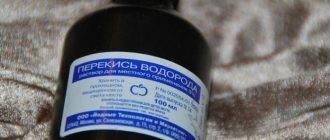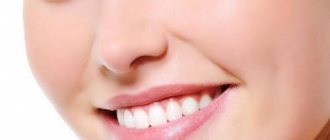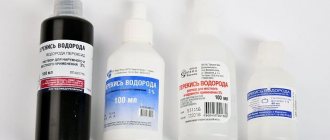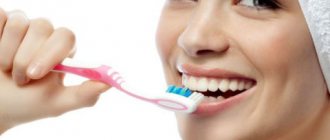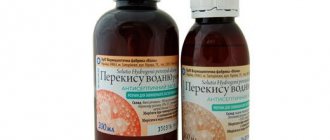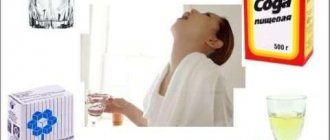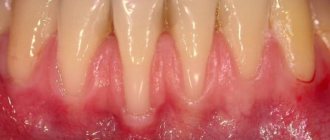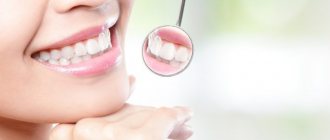Basic cleaning methods
There are 2 main types of carpet cleaning: dry, wet.
In dry form, soda is an abrasive that can remove mechanical impurities, and with warm water it perfectly removes any fats. The main difference between these methods is their effectiveness. Dry cleaning eliminates visible dirt up to 30%, and wet cleaning – from 70 to 90%.
The advantage of the dry method is the ability to use the carpet immediately after the cleaning procedure. After performing wet cleaning, you need to dry the product thoroughly to avoid the appearance of a musty smell, mold, and the start of rotting processes.
Moisture also has a negative effect on all types of coverings, especially if there is parquet under the carpet.
What do cosmetologists think?
Experts warn: hydrogen peroxide should be handled with extreme caution. Neglecting the rules can lead to very unpleasant complications:
- drying out;
- severe irritation;
- peeling,
- burns;
- worsening wrinkles.
Attention! Each person's skin has its own characteristics. And it is very difficult to predict her reaction to a particular substance. To dispel doubts and make sure there are no contraindications, it is better to consult a cosmetologist before starting procedures.
Mask recipes
Masks containing hydrogen peroxide should not be made or applied hastily. Caution and strict adherence to the recipe and safety rules are very important here. Neglecting them inevitably leads to injury to the skin.
If you are going to apply a soda mask, it is better not to steam your skin before doing so. Even if you are one hundred percent sure that this preparatory event will enhance the effect, still play it safe. A simple cleansing of your face from makeup and washing with herbal infusion will be enough.
The next step is to choose the most suitable recipe. Prepare a mask based on it, strictly adhering to the proportions, and begin the procedure.
Classical
To prepare a classic mask, take:
- baking soda – 2 full tablespoons;
- 3 percent hydrogen peroxide - 2 full tablespoons.
The soda must be fresh and not yellowish. Pour it into a clean glass bowl. If there is none, replace it with a glass.
Now pour in the antiseptic. Mix the ingredients thoroughly. The desired consistency of the mass is mushy.
Apply the mask to a previously cleansed face. Remember to avoid the areas around the lips and eyes. The exposure time is no longer than 10 minutes. After this, the product can be washed off with water at a comfortable temperature. Finally, lubricate your skin with a nourishing cream to prevent it from drying out.
Cleansing
The combination of sodium bicarbonate and 3% hydrogen peroxide perfectly cleanses the skin and evens out its tone. To avoid overdrying, it is recommended to add sour cream or yogurt to these ingredients.
To prepare a cleansing mask you will need:
- yogurt without additives (alternative - sour cream) - 1 full tablespoon;
- baking soda - half a teaspoon;
- three percent peroxide solution - 3-4 drops.
First, combine yogurt or sour cream with soda. Then add hydrogen peroxide to this mixture. Mix everything thoroughly. Apply the finished mask to the skin with light movements with your fingertips. Exposure time – 3 minutes. Then rinse off the product with warm running water.
Anti-acne
For an anti-acne treatment mask you will need the following ingredients:
- ground oatmeal - 1 full tablespoon;
- baking soda – 1 full tablespoon;
- 3% hydrogen peroxide – 1 full tablespoon.
First combine the oatmeal with baking soda. Then add peroxide and mix all the ingredients. The consistency of the mass should resemble gruel. If it turns out to be very thick, you can add a little mineral or filtered drinking water.
The finished mask should be applied to previously cleansed skin . Once again, I would like to draw your attention to the fact that we do not touch the area around the eyes. Leave the product on for a maximum of 10 minutes. After this, carefully rinse and wipe your face with tonic.
How to properly care for a frying pan
It is better to use each specific type of cookware in accordance with the operating instructions. Four simple rules are universal for any frying pan.
The product is presented on the market in a wide variety, differing in shape, size, purpose and coating.
- After purchasing, new utensils must be washed with detergent or soapy water.
- Some types of products are lubricated with vegetable oil before use.
- The size of the burner should not exceed the size of the bottom. An open flame will damage the outer coating of the walls.
- Sudden temperature changes are harmful to cookware and can change their properties. Do not put hot pans in the refrigerator and cool them with cold tap water.
We invite you to familiarize yourself with how the lungs work?
what are alveoli? What are alveoli in the mouth, their effect on the dentition Definition of alveoli. To care for a ceramic frying pan, you need to remember just three simple rules.
- Do not use metal accessories.
- Do not expose to temperature changes.
- Wash and remove carbon deposits in a timely manner.
It is important to comply with the operating conditions of the cookware, taking into account the manufacturer’s recommendations and take into account the material of manufacture.
Proper care and careful operation will increase the service life of any frying pan. If you do not neglect the simplest rules, then the dishes will always remain as good as new.
Women's diseases
A common problem for women is colpitis - inflammation of the vagina. As part of complex treatment (suppositories, tampons, ointments, tablets), doctors recommend douching for disinfection purposes.
Article for you:
How to treat diarrhea with walnuts and septums
One of the means used for this is hydrogen peroxide, which kills all pathogenic microorganisms (viruses, fungi, bacteria). Consequently, douching will help with thrush and putrefactive processes.
The solution is prepared as follows. Mix H2O2 (3%) with boiled water (about 38°C) in a ratio of 3:1. The solution should be prepared immediately before use, because it quickly loses its healing properties.
When douching, do not squeeze the syringe - the liquid should not enter the vagina under pressure!
Carry out the procedure for about 7 minutes.
Treatment regimen:
- for acute forms of diseases – 2 times a day;
- for mild symptoms – 1 time per day;
- after the symptoms have subsided - once every 2-3 days.
Do not continue the therapeutic course for more than 3 weeks. Long-term use of hydrogen peroxide leads to disruption of microflora and the risk of developing concomitant diseases.
For pregnant women, only a doctor can recommend the procedure! Do not prescribe treatment yourself!
Ceramic
If the food is burnt or a layer of soot has formed, then the housewife is faced with the question: how to clean a ceramic frying pan without damaging the coating? It should not be rubbed too hard. For washing it is better to use a soft cloth or sponge. The use of powder and abrasive materials is generally prohibited.
Such a frying pan should be cleaned using special products, without hard sponges or abrasive particles.
To remove a small layer of carbon deposits from a ceramic frying pan, you can use alcohol by wiping the walls with cotton wool soaked in it. There is also a method using toothpaste. Thanks to its bleaching properties, it can completely clean light-colored surfaces.
You need to treat ceramic coating with care, then it will last a long time.
Treatment of nail fungus with baking soda
People have long known that baking soda will help get rid of nail fungus. You can use an aqueous soda solution or use it as an additional remedy for drug treatment. For nail fungus, use the following recipes with baking soda:
Currently reading: Treatment of oncology with soda
Dissolve 15 g of soda in two liters of water, add a little liquid or grated laundry soap, mix everything. Dip the affected nail plates into the solution for 20 minutes. Wipe thoroughly with a dry towel, apply antifungal varnish or cream; soda paste. To prepare it, use water, baking soda and lemon.
Pour water into the soda in a thin stream, stirring all the time. The resulting homogeneous mass is applied to the affected nails. Add a few drops of lemon juice on top. A tingling sensation may occur as a result of the chemical reaction. Five minutes after application, the paste is washed off with warm water and soap and wiped dry. To get a good effect, coat your nails with antifungal varnish. Repeat the procedure every three days.
We invite you to familiarize yourself with the Sagittal gap between teeth
How to whiten teeth with hydrogen peroxide and baking soda
Many methods of teeth whitening have been invented today. It is best to do this in your dentist's office. But we don’t have enough time to visit a doctor, and therefore we are looking for traditional methods that allow us to carry out cleaning at home. One of them is teeth whitening with hydrogen peroxide. How effective and safe is the method? Let's figure it out.
What is a raid? These are bacteria and food debris that were not removed in a timely manner. First, a soft plaque appears, which then turns into tartar. This is already a solid formation, inaccessible to any means of influence at home. But you can remove soft plaque yourself using various means:
- Activated carbon;
- lemon juice;
- soda solution;
- iodine;
- hydrogen peroxide.
Peroxide ranks first among home remedies in terms of effectiveness. It reacts with plaque formed on the surface of the enamel and removes it. A chemical process of oxidation occurs, resulting in the formation of oxygen. It destroys the elements of soft plaque. This way you can clean and whiten your teeth.
But be careful! If the result inspires you, you can start using peroxide often, but this has dire consequences:
- thinning of enamel;
- caries;
- loss of teeth.
You can whiten your teeth with home remedies such as baking soda and peroxide, lemon juice, and salt no more than 4 times a year. Otherwise, the result will be unhappy, because for all their effectiveness, the products are aggressive and, if used for a long time or incorrectly, damage the enamel.
Peroxide helps cope with darkening of enamel in the following situations:
- when soft plaque forms due to insufficient oral hygiene;
- when smoking;
- when drinking coffee and chocolate in large quantities;
- with age-related changes in enamel color.
If your teeth are naturally yellowish, you are unlikely to achieve a noticeable effect.
Contraindications
Cleaning teeth with peroxide is not safe for everyone. Even if the specified precautions are observed, the method cannot be used if:
- you have cavities;
- you suffer from periodontal diseases (gingivitis, periodontitis);
- you have a lot of large fillings installed a long time ago;
- crowns are present;
- Diseases such as stomatitis and pharyngitis have not yet passed.
Peroxide can worsen the situation with untreated caries: the cavity will increase, which will increase the possibility of tooth loss. In any inflammatory process, hydrogen peroxide eats away damaged tissue, increasing inflammation.
Old fillings need to be replaced before you begin removing plaque with recipes containing peroxide. Reason: Over time, a space forms between the filling and the tooth. If an aggressive substance penetrates there, it will provoke inflammation.
The same applies to crowns.
You cannot resort to lightening methods until the foci of inflammation due to stomatitis and throat diseases are completely eliminated. This can enhance the inflammatory process, blood supply, activate the work of local immunity, and cause swelling.
If you just had braces removed (or still have them), do not use peroxide for whitening. Teeth have become more sensitive, so enamel damage and uneven whitening are possible.
The following cleansing method should not be used:
- pregnant women;
- nursing mothers;
- people with thin tooth enamel.
Peroxide penetrates not only into the surface, but also into the deep layer of enamel, which will make it even thinner and more susceptible to external influences.
3 best recipes
If you like the idea of bringing your smile closer to perfect with home whitening, try these 3 recipes.
Rinsing
The method is considered the most gentle of all those proposed. Start with it if you are afraid of ruining the enamel.
To clean the enamel, perform the following steps:
- take 2 tsp. 3% hydrogen peroxide;
- mix in a separate container with 2 tsp. water;
- brush your teeth with hygienic paste;
- rinse your mouth with the prepared solution;
- rinse your mouth with clean water.
After the procedure, do not eat or drink for 30 minutes. Otherwise, there is a risk of staining the lightened enamel.
Soda and peroxide
For this method, you will need baking soda in combination with 3 percent hydrogen peroxide, which is sold in pharmacies.
Recipe:
- ⅓ tsp. soda;
- ⅓ tsp. peroxides;
- mix to form a mushy mass;
- apply to teeth;
- massage your teeth with your finger or cotton pad.
Don't use a toothbrush! The product used is already quite aggressive: peroxide oxidizes, and soda contains abrasive particles that scratch the enamel surface.
At the end of the procedure, we rinse our mouth, brush our teeth with industrial paste, and rinse our mouth again.
Enrichment of paste
You can also try this method: add peroxide to a hygienic or therapeutic paste. Recipe step by step:
- squeeze the usual dose of paste onto the brush;
- add 2 drops of peroxide on top;
- add 2 drops of lemon juice.
Brush your teeth, being careful not to press too hard on the brush. After the procedure, rinse your mouth. Refrain from eating for half an hour.
If you want to try any of the methods listed above, visit your dentist first. He must conduct an examination and make sure there is no caries, as well as other diseases.
Try rinsing with peroxide: it is the most gentle on your teeth.
Sometimes peroxide of the required concentration is not available for sale. You can purchase perhydrol (used externally to disinfect wounds and inflammatory skin lesions) at the pharmacy and dilute the solution to make 3% peroxide. Do it right. Mix the products in the following proportions: for 9 g of perhydrol - 100 ml of water (distilled).
Attention! Using the product in a higher concentration leads to burns of the mucous membrane and damage to the enamel!
If you go beyond what is permissible, you risk damaging the deep layers of enamel. The teeth will become matte rather than shiny and will begin to react to high and low temperatures.
This condition will require treatment in the dentist’s office, and it will not be possible to correct the situation in one go.
During the whitening process, use toothpaste with a high fluoride content, which will prevent demineralization.
Advantages and disadvantages
For clarity, we use a table: it shows both sides of the coin.
After viewing it, you will draw your own conclusions about whether it is worth starting teeth whitening with peroxide.
| pros | Minuses |
| Availability, does not require time to visit a doctor | Preliminary consultation required |
| The method helps whiten teeth by 2 shades | It has contraindications: high enamel sensitivity, gum disease, caries. Not allowed to be used in childhood or pregnancy |
| Ease of use, quick results | There is a risk of damage to enamel and gum tissue |
When starting whitening, try first the most gentle of the proposed methods; perhaps it will be enough for a result that will satisfy you.
Dentists' opinion
Doctors do not express strong protests against teeth whitening with peroxide. They agree that the procedure is effective.
Moreover, similar methods are used for whitening in the dentist’s office, for example, lightening the enamel and removing plaque using carbamide peroxide (15% or diluted 35%).
The principle is the same: oxidation occurs on the surface of the enamel, due to which the required whiteness is achieved. Bacteria are cleaned off and plaque disappears.
But here lies the secret: in the dentist’s office, the whitening procedure is not only about ridding the patient of soft tartar and changing the shade of the enamel. The doctor also uses pastes aimed at remineralizing teeth. This way the integrity of the enamel is preserved and caries is prevented.
There is only one way to carry out remineralization at home: brush your teeth with fluoride paste. However, this is not enough to completely restore the damaged layer. This is where the danger lies.
If you decide to lighten your teeth with peroxide, do it very carefully and as little as possible. Visit your doctor's office first and have your tooth decay treated.
Many who have used peroxide for home whitening are satisfied with the results. We read reviews from experimenters to form our own opinion about the effectiveness and safety of the procedure.
The results can be seen if you look at the photos before and after 3-4 whitening sessions. The smile may not be snow-white, but the teeth are clearly brighter at the end of the course.
Have you decided to undergo home whitening procedure? Your steps:
- Visit your dentist.
- Treat pockets of caries.
- Check the condition of the gums: there are no bare areas, deep pockets, or inflammation.
- Consult your doctor.
- For lightening, use only a 3% peroxide solution diluted with water.
- Restore enamel: buy a paste with a high fluoride content.
The main thing is not to get carried away! Doctors do not always welcome whitening even in dental offices: the procedure has many contraindications, and it is even more dangerous to do it at home, without the supervision of a doctor.
If you take care of your teeth, undergo preventive examinations twice a year and coordinate all your actions with specialists. Remember: a snow-white smile is not always an indicator of health, and sometimes achieving it with any effort can be dangerous.
Hello dear readers. You don’t always have the money and time to visit a dentist for teeth whitening. Today I want to share home remedies that will help you whiten your teeth quickly and effectively. But it is worth remembering that you should not get carried away with such a procedure.
Let's start with the fact that a snow-white smile is an attribute of a successful and healthy person. We all strive to be beautiful and “sparkle” with snow-white teeth. In many ways, the color of teeth depends on the natural color of the enamel. The second factor is hygiene.
But, at the same time, plaque accumulates even on the whitest and most well-groomed teeth. Therefore, it is worth carrying out preventive oral hygiene and, if necessary, teeth whitening. But what to do if you can’t visit the dentist? After all, whitening services are quite expensive.
In this article we will answer the popular question: “How to whiten teeth with hydrogen peroxide and soda?”
- Teeth whitening with soda is quite popular among those who are not willing to spend a lot of money on procedures in the clinic.
- For each type of oral cavity, you can choose an individual soda recipe.
- This article tells you how to whiten your teeth at home, which recipe is best to use, and how lemon will help in whitening enamel.
Treatment using the Neumyvakin method
Professor I.P. Neumyvakin conducted many experiments and studies to prove the benefits of soda and peroxide for the human body. The deterioration of human health, according to Ivan Pavlovich, occurs when the acid-base balance in the body is disturbed. In order to adjust this balance, you need to drink a soda solution every day. As a result, it is possible to prevent severe cardiovascular pathologies: heart attack and stroke, and possibly cancer.
According to Neumyvakin, you should drink a glass of hot water with a quarter teaspoon of soda a quarter of an hour before meals three times a day. Three days after starting the dose, gradually increase the dose of soda to a tablespoon at a time. Taking a soda solution daily will help cleanse the walls of blood vessels, which will protect you from atherosclerosis.
Due to poor environmental conditions, the human body constantly experiences oxygen starvation. Hydrogen peroxide will help saturate the body tissues with oxygen.
In his books, the doctor tells how this can be done. He suggests one drop containing 3% hydrogen peroxide, diluted with three tablespoons of water and drunk on an empty stomach 30 minutes before meals or 2 hours after meals. Take this solution three times daily for 10 days, adding one drop of peroxide to each dose every day.
Currently reading: How to use baking soda for nail fungus
Hydrogen peroxide can be treated for a long time and get rid of a large number of diseases.
You can treat in parallel with baking soda and hydrogen peroxide. In this case, Neumyvakin recommends taking them with an interval of 15 minutes. Taking both drugs at the same time may increase your body temperature.
Application options
The method of using a folk remedy to remove old stains depends on the type of dishes. It can be used for cleaning pots, pans, baking sheets, cutting boards or cutlery.
Cleaning the pan
Most often, when cooking, stains form on the outside due to exposure to gas or food splashes. If it was not possible to immediately remove the plaque, and over time the use of the dishes a layer of old fat has formed, then to remove it you need to do the following:
- Pour baking soda into a container.
- Gradually add hydrogen peroxide to it, stirring the mixture. You should get a consistency similar to gruel.
- Using a sponge, apply it to the damaged surface. Leave to absorb for 15-20 minutes.
- Rinse off the composition with warm water using a sponge. If necessary, you can further wash it with dishwashing detergent.
This processing method is not suitable for pans made of enameled steel; scratches may appear on it. To clean it, you need to pour a slurry of hydrogen peroxide and soda into warm water, then dip the dishes in it for 20-30 minutes, and then treat the surface with a soapy solution. This method is more effective for removing contaminants covering the bottom surface.
Cleaning the pan
A coating forms on the frying pan after each cooking due to the use of oil. It is not always possible to eliminate it after using detergent; a greasy film continues to remain. To eliminate it you need to:
- Fill the pan to the level where there is dirt. Add 1 tablespoon of soda to the liquid.
- Bring contents to a boil. To speed up this process and improve its efficiency, you need to cover the dish with a lid.
- Add 2 to 6 drops of hydrogen peroxide, depending on the degree of contamination or the volume of the pan.
- Turn off the fire. Leave to soak for 10-20 minutes.
- Drain the water-alkaline mixture and wash the pan with dishwashing detergent or soapy water.
After cleaning, rinse the pan thoroughly with warm water. If plaque has formed on the outside of the utensils, then you should pour the heated solution into a large container and place the contaminated utensils in it for 15-30 minutes.
Cleaning the baking tray
The baking tray is the most difficult to clean from grease. This is due to the fact that the preparation of the dish occurs under the influence of high temperatures from all sides. Because of this, plaque is absorbed better and faster. After the baking sheet has cooled, it already dries out quite a bit, and removing it is problematic.
An effective solution for this type of utensil consists of 100 grams of soda and 4 tablespoons of hydrogen peroxide. Additionally, you can add 1 teaspoon of dishwashing detergent. Cover the baking sheet generously with the cleaning solution, and after 30 minutes, wash off with a soft sponge and rinse.
Cleaning cutlery
Less commonly, forks, spoons or knives become coated with grease. Due to the oxidation reaction, it can settle on silver or bronze cutlery over time. You can eliminate it as follows:
- It is necessary to place foil on the bottom of the pan and distribute 2-3 tablespoons of soda evenly over it.
- Place cutlery on top of it.
- Pour water so that the liquid lightly covers the forks, knives or spoons. Add 3-5 drops of hydrogen peroxide.
More goodies: Quick and easy ways to clean stove handles from dirt and grease With quick and easy ways to clean stove handles from dirt and grease, you can achieve perfect...
If the greasy deposit has recently formed or is small in size, then you can mix soda with hydrogen peroxide so that you get a consistency similar to liquid gruel. Soak a cotton pad in it and wipe it with table water, then rinse it.
Cleaning the cutting board
Cutting boards made of plastic or wood are easy to use. An obvious drawback is that this material quickly absorbs unpleasant odors and grease deposits. To clean it, you need to moisten a soft sponge in a mixture of soda and peroxide and treat the dishes with it, then rinse with cool water. To remove old plaque, you need to keep it for 20-30 minutes in a solution of these components dissolved in water, then rinse with detergent.
Treating cancer with soda - is it possible?
Modern medicine has made great strides forward in the diagnosis and treatment of cancer. Surgery and chemotherapy are usually used. As a result, cancer cells slow down or stop growing altogether. Chemotherapy treatment significantly prolongs the life of patients, and some of them recover completely.
Doctors sometimes recommend using folk remedies as auxiliary treatment methods. Cancer cells can only exist and multiply in an oxygen-free environment. Using hydrogen peroxide can, to some extent, solve this problem. It would seem that regular consumption of hydrogen peroxide feeds cells with oxygen and should slow down the growth of tumor cells. Scientists conducted many experiments and came to the conclusion that hydrogen peroxide in this case does not give positive results.
We invite you to familiarize yourself with the best methods for eliminating severe toothache
Currently reading: Universal medicine - tea soda
Regarding the treatment of cancer with baking soda, researchers, summarizing their experience, do not make comforting predictions, although there are supporters of such treatment. According to the theory of Italian scientist Tulio Simoncini, people with weakened immune systems get cancer. Candida fungus gets out of control and causes the growth of a malignant tumor.
Baking soda is not widely used as a cure for cancer. This suggests that the treatment method is very questionable. You can waste a lot of time and miss the opportunity to treat with other more effective methods.
Beneficial features
The current arsenal of cosmetic products can cope with probably any dermatological problem. And yet, many people prefer to use products prepared independently from available products. I support this endeavor. After all, this way you can save money and get a result that will completely satisfy you.
The vast majority of women have baking soda and hydrogen peroxide at home . How are they good for facial skin?
The charcoal contained in soda cleanses pores well and corrects sebum production. And sodium acts as an amplifier of other components and accelerates tissue regeneration. Hydrogen peroxide works as a disinfectant and bleach.
A face mask with peroxide and soda provides a powerful effect thanks to the combination of these components. This cosmetic product perfectly cleanses the skin, increases its elasticity, firmness and even smoothes out fine wrinkles. As a result, the face looks healthy and fresh.
Soda
Baking soda is made up of sodium, carbon, oxygen and hydrogen. Now I will tell you how these substances affect the skin.
Sodium enhances all other components. It accelerates the processes of cell cleansing and restoration.
The combination of hydrogen and oxygen is ordinary water. In baking soda, they mitigate the effects of carbon. With the help of water, toxic and waste substances are removed from the skin. In addition, it helps stimulate proper cell function.
Coal is the most important component of soda. It seeps into the pores and cleans them efficiently. Ash improves the functioning of the sebaceous glands, resulting in the elimination of unsightly oily sheen. At the same time, charcoal has healing properties. With its help, minor wounds and microcracks heal very quickly.
Hydrogen peroxide
As already mentioned, hydrogen peroxide is an antiseptic. Thanks to its disinfecting properties, peroxide helps solve several cosmetic problems at once:
- whitens the skin, eliminating freckles and post-acne, eliminating age spots;
- deeply cleanses;
- removes pimples, acne, comedones;
- fights inflammation.
It is very useful to wipe your face with peroxide. Once on the skin, hydrogen peroxide breaks down into water and oxygen. Oxidation occurs. As a result, the epidermis lightens, and the pathogenic microorganisms living on it die.
Traditional recipes for the treatment of nail fungus
Mix apple cider vinegar and hydrogen peroxide in equal proportions and apply to the nail, hold until it fizzes. Wash treated areas and wipe dry. Use as a prophylactic. Take 50 g of slaked baking soda, 400 g of hot water, 50 g of salt, 25 g of 3% hydrogen peroxide and apple cider vinegar, mix everything.
Soak a cotton pad in the solution and apply it to the nail plate, secure with adhesive tape. Do the procedures daily, the effect will appear in a month. Take equal amounts of water and hydrogen peroxide and mix. Soak the affected nail in the resulting solution for half an hour. Wipe the nail and repeat the procedure daily for a month.
For any treatment, you should consult your doctor.
Effects of peroxide
First, let's look at some interesting facts about hydrogen peroxide (H2O2).
- It is found in all living organisms.
- White blood cells produce it to fight bacteria and infections.
- The substance is produced by fruits and vegetables; This is one of the reasons why the gifts of nature are beneficial to the human body.
- The substance is present in breast milk produced by a woman's body during breastfeeding, where it is responsible for increasing the baby's immunity.
- Naturally present in rainwater.
Peroxide is considered a safe antimicrobial agent. Due to its oxidizing effect, it has been used for many years as an antiseptic and disinfectant. Although the use of H2O2 has decreased with the popularity of other over-the-counter medications available, it is still used by many hospitals, doctors, and dentists.
Like many other oxidative antiseptics, peroxide slightly damages the tissue of open wounds, but is effective for quickly stopping capillary bleeding (slow bleeding from small vessels during abrasions), therefore it is used for cleansing and disinfection.
H2O2 can be used as a toothpaste when mixed with an appropriate amount of baking soda. Sometimes used in combination with benzoyl peroxide to treat acne.
How baking soda and hydrogen peroxide can help in everyday life
Hydrogen peroxide is a well-known disinfectant with a wide spectrum of action. In medicine, it is most often used to sterilize wounds. Many years ago, this substance was actively used to treat throats, clean furniture, carpets, and dishes. These magical properties of a universal remedy can make it indispensable in any household.
In combination with soda, peroxide gives an amazing result:
- good disinfection;
- effective removal of carbon deposits;
- effective fat dissolution;
- ability to remove old stains;
- neutralization of unpleasant odors;
- light whitening;
- careful handling of any material.
Important advantage! Soda and hydrogen peroxide are very cheap and simply cannot harm the family budget.
Hydrogen peroxide + vinegar
When combined, they form peracetic or peracetic acid. It is registered as a powerful disinfectant and bleaching agent. But in its concentrated versions it irritates the skin and mucous membranes, is fire hazardous and even explosive.
Not the best cleaning product for a young chemist, would you agree? But in the presence of water, this acid turns back into peroxide and vinegar.
And we will have a lot of water, since we use solutions, not pure substances. But why take the risk?
